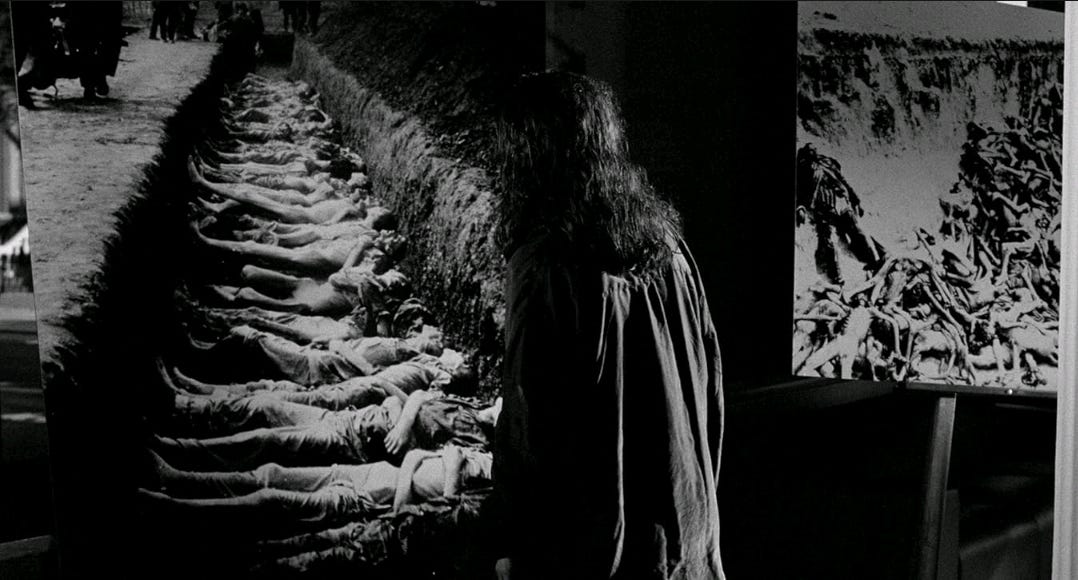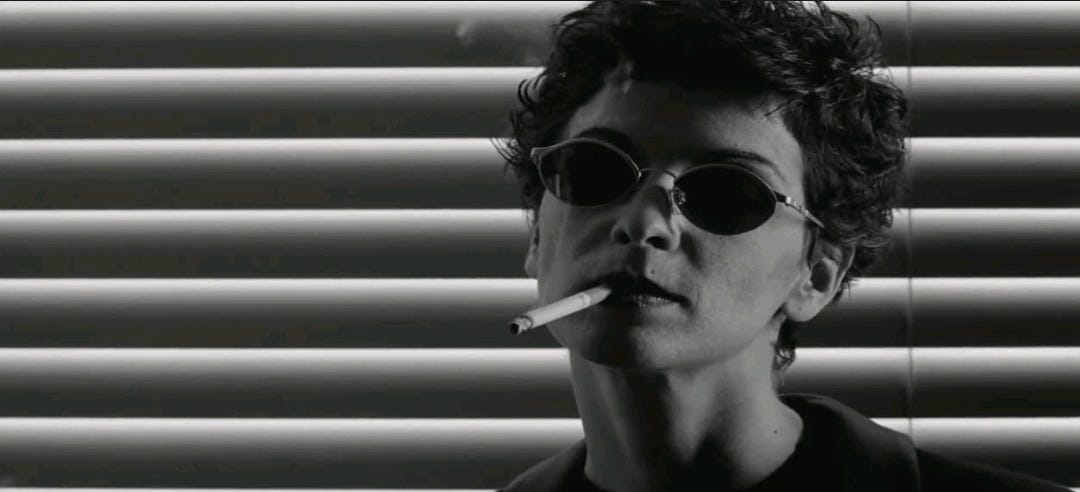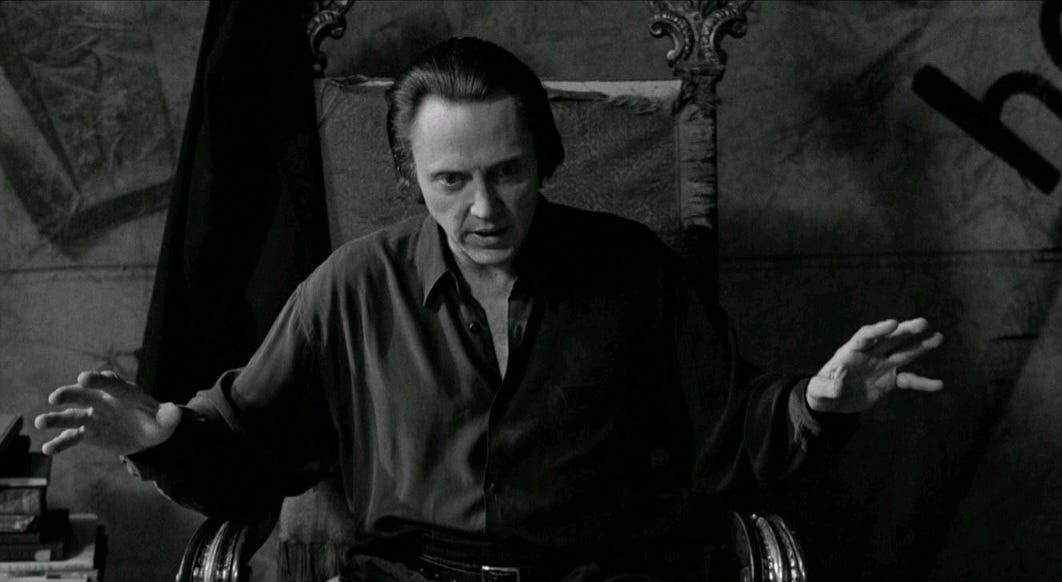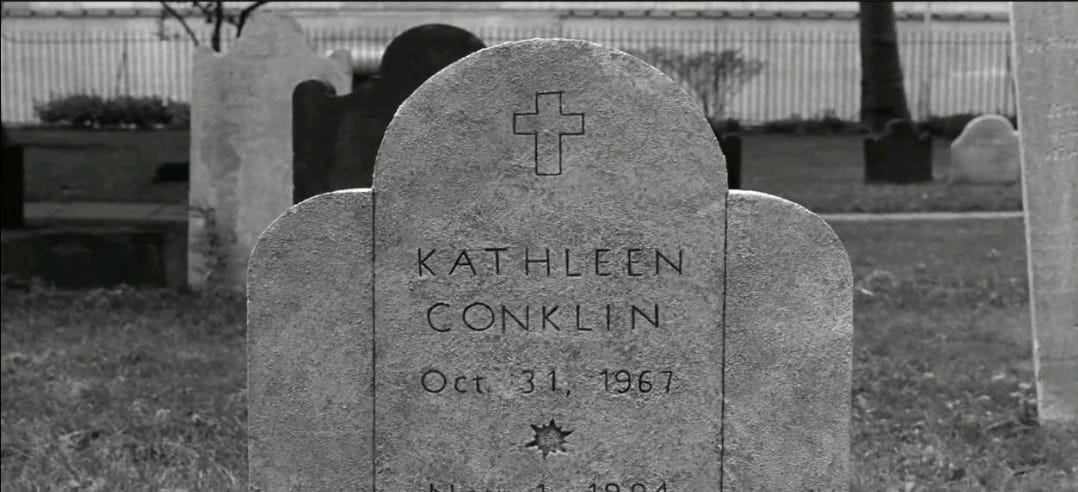This piece will freely discuss plot details from the film.
The Addiction opens on a woman gazing at the bodies of the dead. Kathleen (Lili Taylor) is watching a documentary about the Vietnam War, hearing a sonorous voice intone about the My Lai massacre and the subsequent prosecution of Lt. William Calley. She’s there with her friend and fellow graduate student Jean (Edie Falco), and when the film has ended we hear them debating it, both horrified by the massacre, Kathleen apparently struck by the absurdity of the subsequent trial. Jean argues that something had to be done, however inadequate, that people just wanted to register their disgust at the horrors of the war, but Kathleen sees this as an obvious hypocrisy: “The whole country, they were all guilty!” she says, strident, almost pained. “How can you single out one man?” Abel Ferrara’s The Addiction is a film about a country that’s guilty, about a world that’s guilty, about a post-industrial society infused with horror and genocide; it’s a film about rationalization, about accommodation, about humanity’s struggle to grapple with the absurdity and vanity of life among the mass graves. We’re all drowning in blood every day, the film seems to say; it’s hard to resist the impulse to take a drink.
The imagery of mass death haunts The Addiction, which incorporates footage of the Holocaust as well as its opening confrontation with My Lai. In a deeply religious film, this imagery represents an existential confrontation with the problem of evil, an attempt to understand the direction of moral causation which acts as a consistent through-line: “We’re not evil because of the evil we do,” a key character says towards the end of the film. “We do evil because we are evil.” It’s a classically Augustinian sentiment in a thoroughly Augustinian picture, but Ferrara and his writer, Nicholas St. John, take a more complicated approach to the question. At one point, Kathleen describes her new acquaintance with an American military veteran who works in a slaughterhouse, up to his ankles in blood every day, because “a career after four years of preparation at Princeton couldn’t compare to what they taught [him] in Southeast Asia.” The great atrocities of the twentieth century are emblematic of the human capacity to do evil, but they also create new evils in their turn; we are driven to shed blood by the blood we have been driven to shed, by the lunatic world into which we are born. The original sin of murder re-creates itself in each generation, an education in monstrosity to which humans are continuously subject, a latent capacity for barbarism which is awakened anew by the screams of the dying. As a species, humanity might be irredeemably depraved; as individuals living in the world our species built, we might never have had much of a chance.
Vampirism, in this context, emerges as an attempt to foster the illusion of control. Nietzsche is a constant reference point in the film—a key focus of Kathleen’s graduate studies in philosophy—and the vampires are clearly depicted as Übermenschen of a sort, at least in their own self-conception. Kathleen is ‘turned’ by a vampire who calls herself Casanova (Annabella Sciorra, unbelievably cool) and who makes her attack into a kind of humiliation of the victimized subject, demanding that Kathleen simply tell her to go away, mocking her inability to do anything but plead. Once transformed, Kathleen approaches her own victims the same way, telling one “it’s your will against mine.” Her dialogue, and the newfound confidence of her approach to her alienating world, suggest that vampirism has awakened her will-to-power, has allowed her to transcend the sniveling pieties of her previous life: “Mankind has striven to exist beyond good and evil from the beginning,” says another vampire during one crucial sequence. “You know what they found? Me.” This is, of course, all self-congratulation and power fantasy. These vampires are not sleek and ruthless predators, they’re addicts; without the blood they need they become feral, catatonic. To imagine their victims as morally deserving of subjugation is simply to try and rationalize their own acts of desperation. Even if every human took clear-eyed possession of their own unmediated will, these creatures would still need to get their fix.
That it is a fix is a reality The Addiction faces even more bluntly than you might imagine from the title, or from Ferrara’s characteristic candor about his own struggles with heroin. When first turned Kathleen begins by draining blood from a passed-out man on the street—an addict himself, implicitly—and injects it directly into her own arm to alleviate the unmistakable symptoms of withdrawal. The film’s vampires find it almost impossible to eat—early in her transformation Kathleen is disgusted by the sight of Jean eating a burger—but the blood they need is not really food, does not so much nourish as stabilize. The speed with which the addiction spreads is quietly one of the most frightening aspects of the film: every single attack creates a new vampire, Kathleen is responsible for dozens by the movie’s end, all downstream from Casanova’s one impulsive feeding. The terrifying virulence of this disease, not to mention the imagery of shared needles, seems to evoke the AIDS crisis, a contemporary preoccupation that of course shares conceptual space with drug addiction while introducing its own resonances, racial, sexual. It’s a vision of vampirism that seems to encompass the entire post-industrial world with all its discontents, destined to make monsters of its marginalized people as well as its powerful ones, to infect everyone in due course. The victims of this world become oppressors; the weak are seduced by the illusion of power, by the promise that it’s their turn for a taste. Cannibalism becomes nothing less than a mathematical inevitability.
The most articulate and charismatic cannibal in The Addiction is a vampire named Peina, played by Christopher Walken in a performance that manages briefly to completely run away with the film. He appears in just one sequence, in which he utterly dominates Kathleen, drinking her essentially dry—though he claims, otherwise, to have his condition wholly under control—and mocking as she writhes helplessly in the throes of her need. In his dealings with her he occasionally adopts the sympathetic posture of the reformed addict, referring to his most recent feeding as “the last time I shot up,” but fundamentally he sees her as a pitiful creature, and himself as a masterful one; the pinnacle of vampirism, the amoral ideal that mankind has sought across the millennia. For all his pretensions of transcendence, however, what’s striking is the degree to which his arrogance centers on his successful assimilation into humanity. He can drink and eat and go out by day; he has a job; he can even defecate. “The point,” he says, as she lies depleted on the floor of his bedroom, “is to blend in.” Kathleen, at least at first, imagines her condition as a kind of escape from the farcical banalities of human life, from the need to navigate a complacent bourgeois society, knowing what she does about the brutal violence beneath it; for Peina, however, existence is a struggle to reestablish that juxtaposition, to exist within the very society he knows to be fatuous and cruel. It’s a brilliant hypocrisy, a philosophy in which the height of achievement is “living among the normies,” superior only in some abstract sense and otherwise not really distinct. The correct response to the brutality of the world is to tame the impulse which would separate you from it, to ignore the contradictions, to fit in. The Übermensch is here, and his message is this: stop worrying, and learn to love the bomb.
If Casanova represents the idea that feeding one’s addiction can be understood as an act of will, Peina represents the idea that such an act can overcome the addiction entirely. Kathleen’s experience, however, gives the lie to both notions. First there is a remarkable orgy of bloodshed at a party after her dissertation defense, an attempt to revel in the act of feeding which is nearly derailed by the lunging strength of her hunger and ends in a near-fatal overdose. Then, as she recovers in the hospital, there is a brief flirtation with suicide, cut short by Casanova, who attempts to underline the futility of guilt for creatures whose essence is irredeemable. But guilt in the end spells salvation for Kathleen, as her dissertation supervisor unintentionally predicts early in the film: “We should all hope to feel guilty, to feel pain,” he says, “so that we can seek pardon and ultimately freedom. Guilt is a sign that God is working out your destiny.” Ferrara, characteristically, draws upon the language of Catholicism to literalize Kathleen’s moment of redemptive surrender. She accepts communion—accepts last rites, in fact—from a priest visiting the hospital, and then we see her tombstone, engraved with the Biblical verse “I am the resurrection,” and visited by…Kathleen herself, now apparently capable of surviving the sun. She has reclaimed her humanity not by rationalizing her addiction as an act of radical self-actualization, nor by understanding it as a test of her amoral strength, but by accepting spiritual fallibility in all its painful clarity. She has rejoined the world with a renewed sense of what it takes to live in it.
The real-world prosecution of William Calley was deeply unpopular, and his conviction and sentence to life imprisonment were met with outrage. Georgia Governor Jimmy Carter declared Calley a “scapegoat”—just like Kathleen’s friend Jean—and proclaimed “American Fighting Men’s Day” in his state; President Richard Nixon almost immediately had Calley’s imprisonment converted to house arrest; subsequent appeals reduced his sentence to ten years, of which in fact he served just three and a half. He was the only person ever prosecuted for My Lai, which subsequent journalistic investigations have revealed in any case to be representative of the Vietnam War rather than exceptional; the massacre was everywhere, it was happening every day, it was inseparable as a matter of policy from the war itself. “The old adage that those who learn from history are doomed to repeat it is a lie,” Kathleen says. “There is no history; everything we are is eternally with us.” Among the producer credits for The Addiction appears Antony Blinken, by the time of the film’s release already working as a staffer for Bill Clinton’s National Security Council, later to become Joe Biden’s Secretary of State. Collaborators remember him as a hard worker, a passionate advocate for artists. One wonders what he thought about the film at the time, about its vision of a society suffused by mass death, about its reflection on the absurdity of life amidst the horrors. One wonders if he’s thought of it since.






i used "the addiction" for my research that resulted in a zine. your text is fantastic! the zine is about the vampire myth, and what it meant throughout history. i'd happily send you a copy, you can check the digital version here, if you'd like https://www.are.na/india-t/vampire-myth-zine-research
OMG 79 and rising in philosophy!!! Congrats! You are killing it!